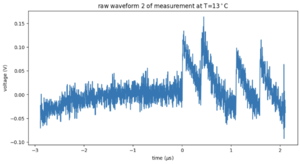Difference between revisions of "Dark count dependence on temperature"
Jump to navigation
Jump to search
(Create page) |
(Add content) |
||
| Line 1: | Line 1: | ||
The dark count rate depends on temperature. We use a peltier element and a dark box to quantify this relationship. | The dark count rate depends on temperature. We use a peltier element and a dark box to quantify this relationship. | ||
| + | |||
| + | == Setup == | ||
| + | @Vikas: can you update this? | ||
| + | |||
| + | == Measurements == | ||
| + | We took dark count measurements at 12 different temperatures. | ||
| + | |||
| + | T = [9.565, 7.664, 1.915, 3.823, 11.484, 5.735, 17.256, 15.32, 13.405, 19.185, 21] degrees Celcius. | ||
| + | |||
| + | For each temperature, around 1500 waveforms were recorded with an oscilloscope. Each waveform is 5 microseconds. You can clearly see the single p.e. peaks already in the raw waveform shown in Figure 1. In Figure 2, a waveform with noise is shown. | ||
| + | [[File:Raw waveform.png|left|thumb|Figure 1: Raw waveform at 13 degrees.]] | ||
| + | |||
| + | == Analysis == | ||
| + | |||
| + | == Conclusions == | ||
Revision as of 14:45, 8 February 2023
The dark count rate depends on temperature. We use a peltier element and a dark box to quantify this relationship.
Setup
@Vikas: can you update this?
Measurements
We took dark count measurements at 12 different temperatures.
T = [9.565, 7.664, 1.915, 3.823, 11.484, 5.735, 17.256, 15.32, 13.405, 19.185, 21] degrees Celcius.
For each temperature, around 1500 waveforms were recorded with an oscilloscope. Each waveform is 5 microseconds. You can clearly see the single p.e. peaks already in the raw waveform shown in Figure 1. In Figure 2, a waveform with noise is shown.
